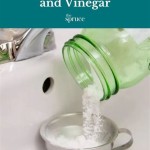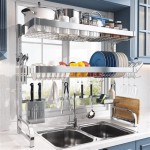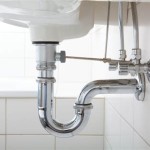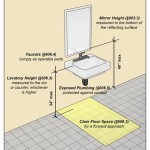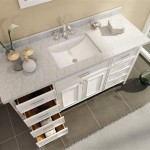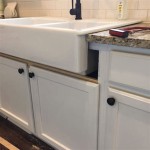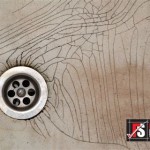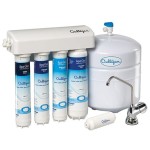How to Clean a Bathroom Sink Overflow
A clogged bathroom sink overflow is a common household plumbing problem that can be frustrating and messy. When the overflow drain becomes blocked, water can back up into the sink, potentially causing damage to your bathroom and belongings. Fortunately, cleaning a bathroom sink overflow is a relatively straightforward task that can be done with a few basic tools and supplies. With the right approach, you can clear the blockage and restore your bathroom sink to proper functionality.
Understanding Sink Overflow Drains
Bathroom sink overflows are designed as a safety feature to prevent water from spilling over the rim of the sink in case the main drain becomes clogged. They typically consist of a small hole located near the top of the sink basin. When water reaches a certain level, it flows through the overflow drain to prevent flooding. However, if the overflow drain becomes blocked, water cannot escape, leading to a backup and potential damage.
The most common culprits for clogged sink overflow drains are hair, soap scum, and other debris that can accumulate over time. These substances can build up in the drainpipe, restricting water flow and creating a blockage.
Step-by-Step Guide to Cleaning a Bathroom Sink Overflow
Cleaning a bathroom sink overflow involves removing the blockage and ensuring the drainpipe is clear. The following steps provide a comprehensive guide to cleaning the overflow drain effectively:
1. Gather Your Materials
Before you begin cleaning, gather the following materials:
- A small bucket or bowl
- A pair of pliers or a small wrench
- A wire coat hanger or a plumbing snake
- Rubber gloves
- A flashlight
- A cleaning solution (vinegar, baking soda, or a commercial drain cleaner)
- A towel or cloth
2. Protect Yourself
Put on your rubber gloves to protect your hands from any potential contaminants in the drain. The water in the sink may be contaminated, so it's best to protect your skin. Ensure you have a clean and dry towel to wipe up any spills.
3. Remove the Overflow Plate
Locate the overflow plate, which is typically a small, circular or rectangular plate near the top of the sink. Depending on the type of plate, you may need to use pliers to gently pry it off. Twist it counterclockwise to loosen it, and it should pull off easily. Be careful not to damage the plate during removal.
4. Clean the Overflow Drain
Once the plate is removed, you can start cleaning the overflow drain. Use a flashlight to illuminate the drain opening, and inspect for any visible blockages. If there is debris obstructing the drain, use the pliers or small wrench to remove it carefully. Be sure not to damage the drainpipe. You may need to use the wire coat hanger or plumbing snake to reach deep inside the drainpipe and dislodge any stubborn blockages. If the wire coat hanger or plumbing snake cannot dislodge the blockage, you may need to use a commercial drain cleaner, but be cautious and follow the instructions on the product label. Never mix different types of drain cleaners together.
5. Flush the Overflow Drain
Once you have removed any visible debris, flush the overflow drain with water to ensure it is clear. If the water drains freely, you have successfully cleaned the overflow drain. If the water still drains slowly or backs up, repeat steps 4 and 5 until the overflow drain is clear.
6. Replace the Overflow Plate
After cleaning the overflow drain, you can reattach the overflow plate. Align the plate with the drain hole and twist it clockwise to secure it in place.
Alternative Cleaning Methods
In addition to the above steps, you can also try alternative cleaning methods to unclog a bathroom sink overflow.
1. Vinegar and Baking Soda
Pour a cup of white vinegar followed by a cup of baking soda down the overflow drain. Let the mixture sit for 30 minutes to loosen the blockage. Then, flush the drain with hot water. This method is safe for most drains and can effectively remove build-up.
2. Commercial Drain Cleaners
Commercial drain cleaners can be effective for removing stubborn clogs. However, use them with caution as they can be corrosive and harmful. Always wear gloves and eye protection when using drain cleaners. Follow the instructions on the product label carefully.
3. Plumbing Snake
A plumbing snake is a long, flexible tool with a corkscrew tip that can be used to dislodge blockages in drains. Insert the snake into the overflow drain and twist it to break up the blockage. Slowly pull the snake back to remove the debris.
Prevention Tips
Prevent future clogs by adopting the following practices:
1. Hair Strainer
Use a hair strainer in your bathroom sink to catch hair and other debris before it can clog the drain. Empty the strainer regularly.
2. Regular Cleaning
Clean your bathroom sink overflow regularly to prevent build-up from accumulating. Pour a cup of white vinegar down the overflow drain once a month to help keep it clear.
3. Avoid Pouring Grease Down the Drain
Grease can solidify and clog drains, so avoid pouring it down the sink. Wipe grease off dishes with paper towels and dispose of them properly.
Cleaning a bathroom sink overflow is a simple task that can be done with a few basic tools and supplies. By following these steps, you can clear the blockage and prevent future clogs, ensuring your bathroom sink functions properly. Remember to be cautious and use the appropriate cleaning methods to avoid damage to your plumbing system. If the problem persists or you are unsure how to proceed, consult a professional plumber for assistance.

Function And Cleaning Of A Sink Overflow Hole Merry Maids

Sink Overflow Cleaning S Maid To Please

How To Clean Sink Overflow In Your Home 6 Tips Kitchen Magazine

6 Simple Steps To Clean Sink Overflow Pipe Pro Tips

Waterdrills Sink Overflow Demo Youtube

How To Clean A Sink Overflow Drain Youtube

How To Clean Sink Overflow In Your Home 6 Tips Kitchen Magazine

Fix For Smelly Sink So Ready A New House Bathroom Drain Cleaning Drains

Clean Your Sink Overflow Easily A Comprehensive Guide

Think Twice Before Using Tiktok S Shaving Cream To Clean Your Sink Drain
